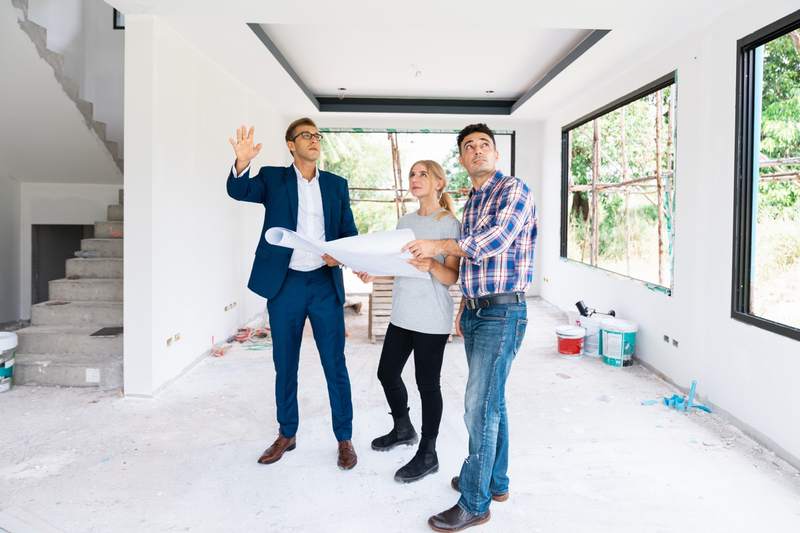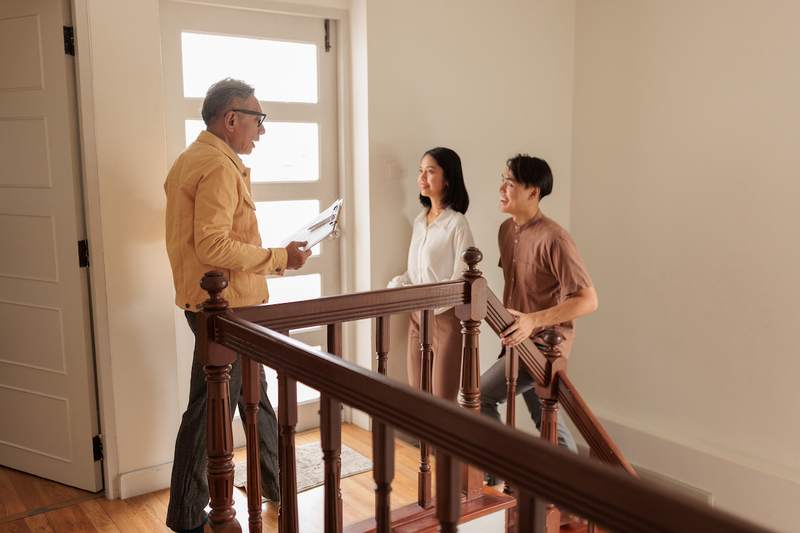When you’re ready to become a homeowner, you might consider buying a new-construction home instead of one that’s already built and lived in.
New-construction homes offer many benefits, including modern design features and the potential to customize. However, it’s important to consider all the details before committing to such a big purchase.
We’ll walk through the different types of new-construction homes, as well as a step-by-step guide to buying one.
Key Takeaways:
- New-construction homes come in several types, including custom homes, semi-custom homes, spec homes, and tract homes.
- The steps to buying a new-construction home can be more complicated than the process to buy an existing home.
- Make sure to weigh the pros and cons of buying a new-construction home before making a decision.
What Is a New-Construction Home?
A new-construction home is a property that was completed within the past year and has never been lived in. It can be a multifamily home, single-family home, condo, or townhouse.
You can purchase a new-construction home either before or after it is built. If you buy a new-construction home before it’s completed, you have the opportunity to participate in the design process and customize the home to your liking.
New-construction homes vs. existing homes
While new-construction homes are less than a year old and have never been lived in, existing homes are different. They usually are more than a year old and have previously had occupants.
A key difference is you’ll typically purchase an existing home from the previous owner rather than a construction company.
Different types of new-construction homes
There are many types of new-construction homes on the market. Here are some examples.
Custom homes
As their name implies, custom homes are designed by professionals, often with the input of the future homeowner. These tend to be one-of-a-kind, upscale homes that have luxurious details and architecture. The future owner may ask the builder or architect to design the home with specific features in mind, such as a mother-in-law suite addition for multigenerational living.
Semi-custom homes
Semi-custom homes are a middle ground between custom homes and predesigned homes. The builder has a basic floor plan and design with modifications that the future owner can request. For example, they may be able to ask the builder to add a half bathroom. These homes are usually cheaper than fully customized homes but more expensive than ones without any custom features.
Spec homes
Spec homes — or speculative homes — are properties that builders construct without a specific buyer in mind. Builders usually design spec homes based on recent trends in homebuilding and what they think will appeal to buyers. These homes are often located in desirable neighborhoods with a strong real estate market.
Tract homes
Tract homes are cookie-cutter homes that follow a set floor plan without much flexibility. Typically, large companies will buy a significant amount of land and construct many homes with similar floor plans and designs. Due to their mass production, tract homes are usually the cheapest option for a new-construction home.
Keep in mind that many tract homes are part of homeowners associations, which come with HOA dues.
Step-by-Step Guide To Buying a New-Construction Home
If you’re curious about how to buy a new-construction home, take a look at this guide.
1. Choose a location
The old adage that real estate is all about location, location, location has validity even when you’re buying a new-construction home. Think about where you want to live, and look for new-construction homes in the area. You’ll want to consider factors such as:
- Quality of local schools.
- Crime rates.
- Nearby amenities, such as parks and gyms.
- Length of your commute to work.
In denser locations, you may need to buy an empty lot and work with a builder to construct a home. In less dense areas, there may be spec or tract homes under construction, or a builder offering custom or semi-custom homes in a new neighborhood.
2. Hire a buyer’s agent
A good real estate agent knows the local market and can help you find a new-construction home that fits your needs. Ask friends and family for referrals, and interview agents until you find one you like.
Be wary of real estate agents provided by the builder’s company. Many builders offer agents who can work with homebuyers, but the agent often acts in the builder’s best interest.
Keep in mind that buyers usually pay the agent’s fees when purchasing a new-construction home.
3. Get preapproved and secure financing
Getting mortgage preapproval is important for any type of home purchase. Work with a mortgage lender to get preapproved so you have a better understanding of your budget.
Possible loan options include:
- Construction loans. These are short-term loans that cover the cost of building or rehabbing a home. Payments often start after a waiting period of six to 24 months, and you can refinance or convert to a conventional loan once the home is built.
- Owner-builder loans. These are construction loans for people who are both the builder and the future owner. You’ll need to show that you have sufficient experience in building homes.
- Bridge loans. Bridge loans are short-term loans that offer cash flow during transitional periods, such as when you’re buying a home while trying to sell your previous property.
- Conventional loans. Conventional loans are traditional mortgages that aren’t insured by any government agency, like the Federal Housing Administration, Department of Agriculture, or Department of Veterans Affairs.
- Jumbo loans. A jumbo loan is a type of conventional loan for an amount larger than the limits set by the Federal Housing Finance Agency.
- Government loans. Some government entities — like the FHA, USDA, and VA — offer specialized loan programs that have specific requirements to qualify.
4. Research and choose a builder
If you’re buying a spec or tract home, then the home is likely already constructed, so you don’t have to worry about choosing a builder. You should still do some research to make sure the home is well constructed, but you won’t be working with the builder directly.
However, if you’re looking for a custom or semi-custom home, choosing a reputable builder is essential. Ask your real estate agent, friends, and family for referrals. You can also look through local listings to find builders and the properties they’ve completed.
It’s a good idea to drive by some of the homes that a builder has constructed to get a better sense of the quality of their work. If you’re able to speak with the homeowners, introduce yourself and find out whether they’re satisfied with how the home is built.
Once you’ve found a few candidates, it’s important to interview each builder. Some helpful questions to ask include:
- How customizable is the floor plan?
- Will this home be part of an HOA?
- Do you offer a warranty program?
- What are the estimated property taxes?
- Are there any development plans for the area in the near future?
- Can you provide a list of recent buyers as references?
5. Design the home
If you’re buying a custom or semi-custom home, then the next step is to sit down with your builder and design the home you want to live in. Work with the builder to create a floor plan and customize your future home. If you have specific design ideas in mind, it may be worth asking whether those ideas are feasible before you settle on a builder.
With spec and tract homes, you’ll likely have very little input — or none at all — on the home’s design.
6. Make an offer and sign a builder contract
Making an offer on a new-construction home is different from making an offer on an existing property.
For one, the price isn’t as flexible because the builder needs to sell for a sufficient profit. You can still negotiate, but there may be less room to do so.
On the bright side, you’re more likely to secure a home warranty or guarantee from the builder, which will cover you if there are defects in the home.
Your real estate agent should have experience in making offers on new-construction homes and can help you navigate the process.
7. Finalize your mortgage and begin construction
Once you’ve signed the builder contract, you can finalize your loan application. You’ll need to provide documents like pay stubs and bank statements, and wait for the lender to approve the loan. Once you’re approved, you can make any required payments or deposits, and start the construction process.
8. Schedule a home inspection
In a home inspection, a professional thoroughly examines the property and identifies any potential issues with it. Just as you would for an existing home, you’ll still want to schedule an inspection for a new-construction home. Even though everything is brand-new, builders still make mistakes, and completing an inspection will give you confidence that the home is properly and safely built.
9. Do a final walk-through
The final walk-through usually happens the day before or the day of closing. It’s your last chance to look over the home before you close on the property. A final walk-through lets you make sure everything is in the right condition, and that no major changes have occurred since the inspection.
10. Close and move in
The last step is to close on your new-construction home and move in. This involves going through closing day, signing all the mortgage documents, transferring the funds, and getting the keys to the home. Once you’re done, you’re ready to move into your new-construction home.
Costs of Buying a New-Construction Home
Buying a new-construction home involves some of the same costs as buying an existing home, as well as other costs unique to new construction. Additionally, there are some “hidden” costs to be aware of.
Upfront costs
- Buying land. You need to own the land that the home will be built on.
- Hiring professionals. A builder, a design consultant, and an architect are needed for custom projects. Don’t forget that buyers also typically pay their real estate agent’s fees in a new-construction home purchase.
- Preparing the site and laying the foundation. Before the builder can construct the home, the property needs to be cleared and leveled and have a foundation laid.
- Down payment. Like with any home purchase, you need to save for a down payment.
- Taxes and insurance. In addition to the regular taxes and insurance, you may need additional liability insurance during the construction process.
- Closing costs. Closing costs for a new-construction home are similar to those for other real estate transactions.
Ongoing costs
- Monthly payments. You’ll have to make monthly payments, which include mortgage payments that start once you’ve moved in, as well as payments on the loan you used to buy the land.
- HOA fees. If your home is part of an HOA, you’ll have to pay monthly HOA fees.
- Taxes. Your local government will assess property taxes that you must pay, typically quarterly or through your monthly payments.
- Insurance. You’ll need homeowners insurance, which covers losses and damage to your home. You may want to purchase other policies, like flood and earthquake insurance, depending on where you live.
- Maintenance, repairs, and utilities. You’ll have to pay monthly utility bills. On top of that, even new-construction homes need maintenance and repairs. Budget about 1% of your home’s value per year for both.
‘Hidden’ costs
- Building delays. Construction might not go as planned. If you were planning to move into your new-construction home on a specific date, you may have to pay for short-term housing while waiting for construction to finish.
- Upgrades. Many spec or tract homes come with cheap, basic appliances. If you want to upgrade to better appliances, it will cost you.
- Painting. You’ll pay for paint when building a custom home. For spec and tract homes, you’ll have to pay extra for approved custom colors, or hire a painter after construction finishes.
- Lack of representation. If you use the builder’s agent instead of your own, the agent might not work in your best interest, which could lead to higher fees.
- Utility connections. “Connecting to water, sewer, gas, and electrical lines can be expensive, particularly if the lines need to be extended to reach your property,” says Whitney Hill, CEO of SnapADU, a San Diego-based building company.
Pros and Cons of Buying a New-Construction Home
Here are some of the benefits and drawbacks of buying a new-construction home.
Pros
- Everything is brand-new. Buying a new-construction home means you can be confident that the appliances and other features are up to date. Existing homes may have older appliances that are energy-inefficient or need some maintenance.
- Some homes are customizable. If you’re working with a builder on a custom or semi-custom home, you can include specific features that you want.
- The building is up to code. Building codes have changed over the years. Whether it’s old knob-and-tube wiring or outdated plumbing, buying an existing home can mean dealing with older technology and safety standards. New-construction homes are designed to current standards, which can improve safety and make it easier for contractors to make upgrades in the future.
- New-construction homes are more efficient. The energy efficiency of homes has increased over the years thanks to new design practices and improved technologies, such as better insulation. Newer homes will usually cost less to heat or cool.
- Less maintenance is required. Newly built homes will typically cost less to maintain. With proper care, you can keep maintenance costs low for a long time.
- Most come with a builder’s warranty. Many builders offer a home warranty that will cover appliances and other things if they break.
- There are buyer incentives for financing. If you work with the builder’s lender, you may be eligible for incentives related to financing the purchase. Some builders will cover part of your closing costs or pay for points to help you secure low rates with certain lenders. Still, it’s important to shop around and compare offers from multiple lenders.
Cons
- New-construction homes usually cost more. Buying a new home tends to be more expensive than buying an existing one. You need to pay for the land, building materials, labor, and more. You’ll also likely pay higher property taxes for a new home.
- Your move-in date can be delayed. Construction doesn’t always go according to schedule. You could wind up spending money on rentals while waiting for the home to be move-in ready.
- Builders must be vetted. You need to be careful about vetting the builders you work with and making sure they do quality work. Otherwise, you may end up paying a lot for shoddy work.
- There may be risk of off-gassing. Some materials used in new-construction homes can release chemicals into the air for weeks, months, or even years after installation. These volatile organic compounds can be hard to notice, but they may lead to negative health effects after long periods of exposure.
- You have less negotiating power. There’s less room to negotiate when buying a new-construction home because the builder needs to recoup costs and turn a profit. People selling existing homes are typically more flexible on pricing.
- Landscaping can take time to mature. Good landscaping can take a long time to mature. Trees take years or decades to grow, so you might have to deal with less appealing landscaping for quite some time.
New-Construction Home FAQ
Here are answers to some frequently asked questions about buying a new-construction home.
Some common mistakes people make when buying a new-construction home include not vetting their builder, working with the builder’s agent without looking at other options, and not preparing for all the costs.
New-construction homes tend to hold their value or increase in value over time. However, like any property, they may lose value in the short term due to market volatility.
The average new-construction home can last for as long as a century, but routine maintenance can extend its lifespan.
The Bottom Line on Buying a New-Construction Home
Buying a new-construction home isn’t for everyone, but it could be a good option for people who want to customize their dream home and enjoy a space that no one else has lived in before. Before choosing a new-construction home, weigh the pros and cons and get a thorough understanding of the process to decide whether it’s right for you.






